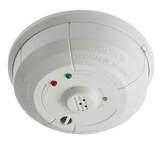CARBON-MONOXIDE CAN BE DEADLY. BASIC AWARENESS AND MONITORING CAN PROTECT YOUR HEALTH AND HOME SAFETY. Carbon monoxide or CO is an invisible and odorless gas that is produced when any fuel is burned, including coal, wood, charcoal, oil, kerosene, propane, and natural gas. This gas can come from sources such as oil furnaces, water heaters, space heaters, dryers, barbecue grills, car exhaust fumes, wood-burning stoves, gas ovens, and fireplaces. The threat of CO poisoning or death arises if any fuel-burning appliances malfunction. It is important to note that every year, about 170 people die from CO production in the United States alone (United States Consumer Product Safety Commission, n.d.). The effects of carbon monoxide can cause damage to the lungs and heart if inhaled. Initial symptoms of CO exposure present as headaches, fatigue, shortness of breath, nausea, and dizziness. In severe cases, symptoms may progress to mental confusion, vomiting, loss of muscular function, unconsciousness, and even death. Those who are most at risk of long-term effects of carbon monoxide poisoning are children and the elderly. Investing in a carbon monoxide detector is the first step towards reducing health risks related to CO. When installing a CO detector, it is crucial to check for a manual to fully understand how to operate the detector and ensure it is properly set up. The detector should be placed in an open area that is not covered by furniture or drapes and not near fuel-burning appliances. It is also recommended to test the batteries every few months and avoid using fuel-burning devices inside the house or being in a car, truck, or motorcycle in an enclosed area. If the CO detector goes off, the next steps to ensure safety are to go outside for fresh air, call emergency services, check to see if all persons are accounted for, and refrain from using the fuel-burning appliance that caused the issue until it has been properly fixed by a trained professional. Although there are many things to look out for, all of the steps are necessary to keep not only yourself but also others safe. Reference: United States Consumer Product Safety Commission. (n.d.). Carbon Monoxide Fact Sheet. U.S. Consumer Product Safety Commission. Retrieved February 17, 2023, from https://www.cpsc.gov/safety-education/safety-guides/carbon-monoxide/carbon-monoxide-fact-sheet
|
Archives
June 2023
Categories
All
|
|
Change your mind at any time by clicking 'unsubscribe' in any email you receive or by contacting us at [email protected]. We will treat your information with respect. For more information about our privacy practices please see our privacy policy. By clicking above, you agree that we may process your information in accordance with these terms.
In compliance with all GDPR requirements- you can request any data you’ve shared with Red Feather to be permanently deleted from our records by contacting us at [email protected]. |
WORKING WITH HOPI AND DINÉ
COMMUNITIES FOR HEALTHIER AND SAFER HOMES.
LAND ACKNOWLEDGEMENT: The Red Feather program office sits in an area that is sacred to over 14 local tribes, including the Diné, Hopi, Havasupai, Hualapai, Zuni, Pueblo, and Kaibab-Paiute peoples. Some of these nations are represented among the Red Feather staff, and some not. We humbly acknowledge this area’s Indigenous nations, original stewards and Native descendants who will forever know this place as home. We share a responsibility to recognize and acknowledge the people, cultures, and histories that make up our community. *Adapted from the Flagstaff City Council land acknowledgement developed by the Indigenous Commission

If you have a disability that limits your ability to access our facilities, please contact us so we can arrange for an alternative meeting location. See our ADA access plan here.
This institution is an equal opportunity provider. |



 RSS Feed
RSS Feed

